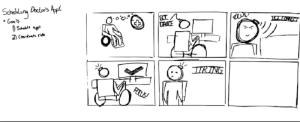
Struggling to find the best talent on the market? Well, the market has become a very big place, and the most skilled talent aren’t necessarily the people in your neighborhood. If you want to recruit the cream of the crop, it might be time to bring your business to them — in a manner of speaking. Today’s top professionals prefer freedom, flexibility and mobility. To engage and retain them, we need to champion a mobile work culture.
The Age of Digital Nomads
Human history, for anthropologists, used to be measured by the tools early people produced. This led to the three-age system: stone, bronze and iron. If we were to continue defining our evolution through elements and the products they enabled, we might very well christen this the Lithium Age.
One of the most salient qualities of modern economics and labor is the on-demand nature both are embracing. This project-based “as a service” paradigm defines how we live and work today. Mobile technologies not only make this possible, they’re also the catalyst. We lead online lives. We rely on wireless, on-demand devices to accomplish our goals, both on the job and at home. As a result, we’re also witnessing the rise of a truly global community — a concept that has transcended philosophy to take its place as a new reality. Borders, both physical and ideological, are disappearing.
Mobility enables all of this, yet not without a sense of irony. Although businesses are eager to capitalize on the on-demand economy, few are embodying the essence of it by creating on-demand offices: a mobile work culture for a mobile workforce.
The Case for Mobility
Each year in the staffing industry, we see advances in digital ecosystems that streamline the ways talent integrate with their peers, employers, recruiters and the world in general. Match-making apps such as eHarmony and Tinder have inspired job seeking technologies like Switch, Jobr, Blonk, Weave and others. Education is becoming digitized as Massive Open Online Courses (MOOCs) transform academia. In fact, MOOCs are positioning themselves to become the next frontiers in sourcing, engaging and hiring.
Immediacy and on-demand access are the themes driving workers and business leaders alike. This year, companies that fail to create mobile-friendly job tools will be left behind. According to Pew Research, 40 percent of job seekers rely on mobile devices exclusively when scouting and applying for positions. That figure rises to 53 percent among 18- to 29-year-olds. Close to 80 percent of U.S. candidates say they would apply for jobs on their phones if HR tech companies streamlined the process and launched platforms designed specifically for the mobile experience. According to Software Advice, 43 percent of Millennials consider SMS messaging a professional recruitment approach.
Anyone who wants to reach and engage prospects must champion a positive mobile experience. Yet, that’s just the beginning. Our efforts can’t stop at recruiting. Workers are increasingly turning to non-traditional employment arrangements to satisfy their work-life goals. They’re setting their own schedules, choosing their employers and determining their own work arrangements. They rely less on the auspices of corporations and more on their entrepreneurial spirit. In order to continue attracting and retaining this nomadic talent, we need to make our business cultures just as fluid and mobile.
The Business Benefits of Mobility
According to CITO Research, businesses recognize the power and benefits of mobility. Nearly 70 percent of all respondents cited improved business processes as the motivation to adopt a more mobile culture. And studies from several years ago already proved the virtues of remote work and virtual offices, especially in context of reducing overhead costs. Today, however, a push toward mobility is accomplishing much more: increased satisfaction, a stronger competitive edge, new revenue opportunities, cost savings and attracting new talent.
As Daniel Newman, co-CEO of V3B, writes in Forbes, “Employee mobility leads to 30 percent better processes and 23 percent more productivity — and 100 percent more satisfied employees.” A mobile work culture offers a wealth of benefits to modern companies.
- Mobility, Newman explains, allows outdated business processes to be updated. Performance reviews, for example, have become more effective and meaningful through mobile models: “Performance management tools are available for companies and offer regular checkpoints, goal appraisals, and performance objectives.”
- Mobility enhances employee engagement and leads to a more connected team.
- When employees work from their home locations, they can better manage their time — taking care of family obligations while scheduling work during off-hours to meet deadlines.
Most importantly, mobile workers are happier and more productive. As Newman writes, “Mobility increases employee happiness — and we all know that happier employees get more done. Empowered employees display more productivity and efficiency while they’re on the clock. Mobile devices and platforms like the cloud permit heightened mobility and encourage creative innovation without being strapped to a desk. This freedom results in a more efficient worker, a competent workplace, and a better bottom line.”
Creating a Mobile Business Culture Without Losing Touch
The most progressive organizations have already become early adopters of enterprise social networks. Facebook at Work, Tibbr, HipChat, Slack and Jive are quickly gaining a following within companies of all sizes. Last year, for example, Slack reached two million users. Through these mobile platforms, workers from any location can easily communicate and collaborate with other team members in real time. Combined with breakthroughs in streaming video apps, a mobile work culture begins to mirror a physical office space.
Live video and messaging systems — such as Periscope, Kik, Google Hangouts, Snapchat, Meerkat and others — are dramatically changing the way workers interact and learn. That’s a key finding in a study of more than 4,000 international employers by the BlueJeans Network. Over 70 percent of respondents believe video can improve the way they communicate with colleagues. Another 69 percent feel that live video systems in the workplace will bolster retention across all levels of the organization.
We know that collaboration and interaction are paramount to business success. And 85 percent of those surveyed by the BlueJeans Network assert that video has become a routine aspect of their everyday lives. Yet only 28 percent report that their employers actively encourage the use of video communications at the office. The reality is that we have all the tools at our disposal to create a mobile work culture without sacrificing interpersonal rapport, real-time collaboration and live communications with co-workers, no matter where we are.
Creating an on-demand office environment for mobile talent requires only a commitment and a few suggestions to ensure consistency, security and buy in. Here are some best practices, courtesy of Daniel Newman:
- Make a concerted effort to identify key apps that fit your business culture, and promote those apps within the company.
- Also choose apps or mobility platforms that address security issues likely to impact your organization, talent and industry. Close to 70 percent of employees who resist mobility cite security and privacy concerns.
- Invest in apps that optimize your company’s core operational and process efficiencies. This helps foster user adoption — employees will quickly realize the benefits because the systems are making their work easier.
- Select apps and systems that offer robust multichannel support. This eliminates the risk of technical issues for people with different device types (phones, tablets), operating systems, versions and so forth. You’ll also curb costs, as employees can use their own devices rather than the company purchasing compatible units.
In the fiercely competitive race to procure the finest talent, companies must expand their reach and develop ways to bring the work to the workers. Technologies are helping to make this possible, allowing for borderless societies and workplaces. Outside the office, they’re strengthening human experiences, health, lifestyles and perspectives. We’re living in a dynamic world with equally dynamic talent. If we insist on the static processes and offices of the past, we may find ourselves mere spectators in the march of progress.
Business & Finance Articles on Business 2 Community(55)








